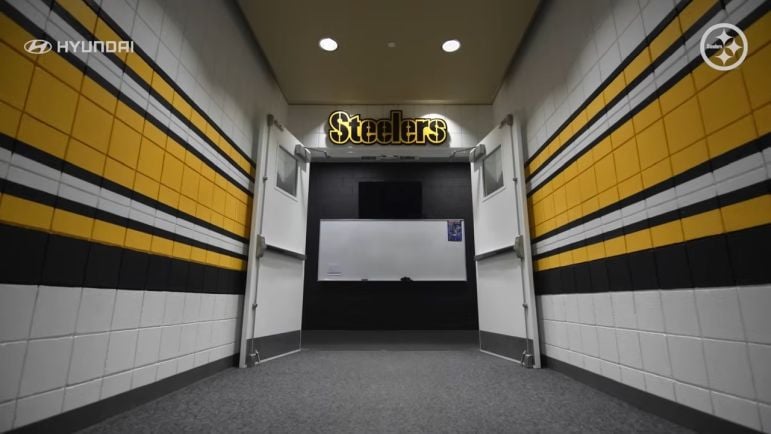The Pittsburgh Steelers have played 92 seasons in the NFL, their 93rd starting in just a few months. There have been highs, lows, and everything in between. In a new series we’ll use to pass the time of the offseason, I’m ranking all of them. From the worst season in franchise history to the best, which means picking which of the six Super Bowl winners came out on top. Not an easy task.
We’ll break this series down into parts, (roughly) 10 at a time, working from worst to best. One small caveat. I won’t be including the team’s two merger years, 1943 and 1944 where Pittsburgh combined with the Philadelphia Eagles and Chicago Cardinals due to a shortage of players because of WWII. Since these were merger years where Pittsburgh wasn’t fully its own entity, they fall into a separate category. We will rank the other 90.
Ranking The Steelers’ Seasons (No. 80-71)
80. 1933 season (3-6-2 record)
Pittsburgh’s first season made it out of the “worst of the worst.” Barely. Winning three games as a debut team still similar to the sandlot Rooney teams formed around that time, the team (called the Pirates until 1940) hung with the other NFL bottom dwellers. Against the big boys? They got blown out. Downed 23-2 by the New York Giants in the season opener. An even uglier 47-0 loss to the Green Bay Packers.
The Steelers (I’ll refer to them as such going forward to avoid confusion) only scored in double digits three times. The team ended the year with three touchdowns to 40 interceptions, bad even for that era. Since 1933, they’re one of only six teams to throw 40 or more picks.
Pittsburgh finished the year with only eight touchdowns. Its opponents had 30. “Star” Angelo Brovelli struggled to find his footing. And the Steelers lost their final three games.
There were bright spots. The franchise’s first win came in Week 2, defeating the Chicago Cardinals in part thanks to a 99-yard pick-six by “Butch” Kottler, the team’s longest pick-six until James Harrison’s iconic Super Bowl moment. Portly kicker Mose Kelsch booted the go-ahead extra point. And Pittsburgh upset the Boston Redskins, 16-14, on the road.
Still, the most notable thing about the year was that it was the first. That was historic. The play? Forgettable.
Inaugural season, better than expected, still dominated by every major opponent: lost to the Giants by 21 and 24, Packers by 47; scored double digits just three times; 3 TDs, 40 INTs; eight different players threw at least 3 INTs; eight total touchdowns, opponent had 30; one of six teams since 1933 to throw 40+ INTs in a season
Notable: Due to Blue Laws that wouldn’t be repealed until after the 1933 November elections, Pittsburgh played all but one home game on Wednesday, not Sunday. The only Sunday game in the city ended in a 32-0 loss to the Brooklyn Dodgers. It remains one of the 10 worst Sunday home losses in franchise history.
79. 1955 season (4-8 record)
Pittsburgh started hot, 3-1 in part to two wins over the New York Giants. The year went into the dumpster down the stretch. The Steelers lost their final seven games, several in uncompetitive fashion: 24-0 to the Philadelphia Eagles and two blowout defeats to the Cleveland Browns, 41-14 and 30-7.
The 30 interceptions Steelers quarterbacks threw were most in the NFL. The offense finished last in scoring. The defense was next-to-last in points allowed. The Steelers rushed for the league’s fewest yards and the offense turned the ball over at least five times in half of their 12 games. Pittsburgh finished last in the NFL East Division, sixth out of six teams.
Wide receiver Ray Mathews was a playmaker at more than 18 yards per catch, making the Pro Bowl. Rookie first-round pick OT Frank Varrichione made his first of five Pro Bowls. The defense had more bright spots with CB Jack Butler, DL Ernie Stautner, and DL/LB Dale Dodrill all making the Pro Bowl.
Despite winning four games, the team’s average outcome was losing by more than a touchdown.
Notable: Jim Finks, the franchise’s first true quarterback after switching from the Single Wing offense in 1952, led the NFL in passing attempts, completions, and passing yards. The only other time that’s been done in Pittsburgh was in 2018 with Ben Roethlisberger.
78. 1935 season (4-8 record)
Four wins marked the team’s most over its first three seasons and Pittsburgh finished the year third in the division. But when the Steelers lost, they lost hard. A 42-7 defeat against the New York Giants and two ugly showings against the Green Bay Packers (27-0, 34-14). The team ended the year with a minus 109-point differential. Like the ’33 season, the Steelers finished the year with 40 interceptions, meaning two of the six NFL teams to do so since 1933 were Pittsburgh.
The team’s “leading” rusher finished with 112 yards. The “leading” receiver had just 178. Despite that, the Steelers finished fifth out of nine teams, scoring a sizzling 8.3 points per game. There were wins over the Philadelphia Eagles and Chicago Cardinals, who went on to win six games, but the year was ugly overall.
Notable: Quarterback Johnny Gildea had a tough go. He threw 20 interceptions on just 105 attempts, completing only 26.7 percent of his passes. His 19-percent interception rate is the second-worst in NFL history of quarterbacks with 100 or more attempts. He’s only ahead of the Green Bay Packers’ Stan Heath, who threw a pick on 24.5 percent of his throws in 1949. The 30s weren’t the era for passing. but Gildea is historically one of the worst.
77. 1967 season (4-9-1 record)
A record that earned Pittsburgh a last-place finish in the NFL Century Division. The Steelers’ offense and defense finished slightly below average. Though it played a handful of games, the team started the season 1-5. Swept by the Browns, the Steelers turned the ball over at least once every game. The team threw 29 interceptions and leading rusher Don Shy only ran for 341 yards.
The best moments of the year came at the beginning and the end. Pittsburgh began the season by blowing out George Halas’ Chicago Bears, 41-13, and ended it by defeating Vince Lombardi’s eventual Super Bowl champs Green Bay Packers, 24-17, on a muddy mess of a field. The Packers fumbled seven times.
Notable: Wide receiver J.R. Wilburn caught 12 passes for 142 yards and a score in a Week 6 loss to the Dallas Cowboys. No Steeler would record more single-game receptions than Wilburn’s 12 until WR Courtney Hawkins hauled in 14 in a 1998 loss to the Tennessee Titans.
76. 1964 season (5-9 record)
Pittsburgh finished sixth of seven teams in the division. Like others on this list, the Steelers started the year with some hope thanks to a 3-2 record after five weeks. But the bottom fell out with a five-game losing streak midseason, punctuated by a 30-0 shutout to the Washington Redskins.
The Steelers completed only 43 percent of their passes, easily the worst mark of the NFL’s then-14 teams (the league average was more than 51 percent). Pittsburgh ended the year with a minus-62 point differential. Eight turnovers contributed to a Week 1 loss to the Los Angeles Rams.
How about something positive? Pittsburgh swept the New York Giants, beat Tom Landry’s Dallas Cowboys, and knocked off Washington in the rematch. RB John Henry Johnson rushed for 1,000 yards and made the Pro Bowl and All-Pro squads.
Notable: Defensive lineman John Baker led the team with 12.5 sacks, finishing top 10 in the league. He’s the man responsible for the hit on QB Y.A. Tittle in 1964, leading to one of the most iconic photos in football history.
75. 2003 season (6-10 record)
The first team on our list that can be remembered by the majority of Steelers fans. Six wins is the best of any team so far, but it was also over a 16-game season. And Pittsburgh’s losses hit hard. A 21-point defeat to the Kansas City Chiefs in Week 2, 17 to the Tennessee Titans in Week 4, an especially painful 33-13 loss at the hands of the Cleveland Browns and later in the year, a 16-point deficit against the San Francisco 49ers.
But perhaps the ugliest loss of the season came in Week 15, 6-0 to the New York Jets. QB Tommy Maddox couldn’t complete half his passes, Jeff Reed missed two field goals, and the Jets made two first-half kicks to win one of the most boring games in recent memory.
Pittsburgh’s season ended with an overtime loss to the Baltimore Ravens. It’s the last losing season the Steelers have experienced.
Only two Steelers finished the season with at least 400 rushing yards, Jerome Bettis and Amos Zereoue. Only two receivers crossed 800 yards, Hines Ward and Plaxico Burress. And only two players had more than five sacks, Kimo von Oelhoffen and Jason Gildon.
The silver lining? The bad year gave Pittsburgh the 11th overall selection in the 2004 NFL Draft, leading to QB Ben Roethlisberger and the start of a new Super Bowl-winning era. Teams that you won’t see on this list for quite some time.
Notable: WR Antwaan Randle El returned two punts for touchdowns that year, becoming one of just three Steelers to accomplish it and the first since Louis Lipps in 1985. Randle El would repeat the feat in 2005, the first and only Steeler to do so in two seasons.
74. 1951 season (4-7-1 record)
Back to the black-and-white era for the Black and Gold. Pittsburgh began the year 0-3-11 and was shut out in two of its final three contests, turning it over 16 times across that span. The defense allowed 28-plus points in one-third of the Steelers’ games.
Pittsburgh tied for last in the NFL in scoring at 15.3 points per game. It ranked third in the NFL with 80 punts.
TE Elbie Nickel and RB Lynn Chandnois were the offensive bright spots.
Notable: Pittsburgh began the season with a 13-13 tie against the New York Giants. To date, it’s the fifth instance the Steelers opened a year with a draw. The franchise also did so in 1940, 1963, 1966, and most recently in 2018 against the Cleveland Browns.
73. 1937 season (4-7 record)
A fast start and miserable finish. Sound familiar? Pittsburgh began 2-0 with a 27-14 win against the Philadelphia Eagles and 21-0 versus the Brooklyn Dodgers. But the team lost its next five games. Over the season, the Steelers were shut out three times. The offense had its moments, registering four games with 20-plus points. However, the Steelers were held to single digits in six others.
Johnny “Blood” McNally served as player/coach and finished second on the team in receiving yards while chipping in a kick-return touchdown.
Pittsburgh lost its finale, 23-0, to the Brooklyn Dodgers in front of 3,700 fans at Forbes Field. The team threw triple the number of interceptions (27) as it did touchdown passes (nine).
Notable: Bill Davidson finished the year with a rushing, receiving, and interception touchdowns. He’s the first and one of just three Steelers to ever achieve that in a single-season. The last occurred in 1947. No NFL player has done it since famous broadcaster Frank Gifford did so for the New York Giants in 1953.
72. 1948 season (4-8 record)
There’s not much more to say about this season that hasn’t been said about the others. A 2-1 start, a 2-7 finish. The high point of the year came in a 38-7 win over Curly Lambeau’s Green Bay Packers. But that was muted by two ugly losses to the Philadelphia Eagles, 34-7 and 17-0. At least the Steelers’ defense finished above average, fourth out of 10 teams.
WR Val Jansante and TE Elbie Nickel led the way offensively. Defensively, Tony Compagno recorded seven of the Steelers’ 13 interceptions.
Notable: This was the first year for head coach John Michelosen. Hired at just 32 years old, he is the youngest head coach in Steelers’ history and remains the third-youngest NFL coach ever hired at the start of a season. It wasn’t until 2007 when 31-year-old Lane Kiffin was hired by the Oakland Raiders that Michelosen’s streak was broken. Sean McVay passed both in 2017. It should be noted Harland Svare was younger than Michelosen when hired in 1962 but that came midway through the Los Angeles Rams’ season.
Michelosen coached for four seasons before being let go. He returned to become an assistant coach for the next-door Pitt Panthers, a job he held in the late 1930s.
71. 1936 season (6-6 record)
Perhaps the franchise’ first-ever .500 season should get a little more love on this list. But it was still a lopsided negative. Pittsburgh finished the year with a minus-89 in point differential, never scoring more than 17 in a game. Over the team’s final four, the Steelers combined to post just 15.
The season started 3-0 but slid from there, ending with a 30-0 defeat to the Boston Redskins. Ed Matesic led the NFL with 16 interceptions despite 138 pass attempts. Pittsburgh had just 10 touchdowns in its favor while allowing 27.
Notable: Pittsburgh reached a 6-3 record by Week 9 and needed just one more victory to finish above .500. It couldn’t pull it off. The Steelers first winning season wouldn’t come until 1942. From 1933-1957, the franchise registered just three winning seasons.
Ranking Steelers’ Seasons (Recap)
90. 1941
89. 1965
88. 1934
87. 1939
86. 1969
85. 1940
84. 1945
83. 1968
82. 1938
81. 1988
80. 1933
79. 1955
78. 1935
77. 1967
76. 1964
75. 2003
74. 1951
73. 1937
72. 1948
71. 1936







